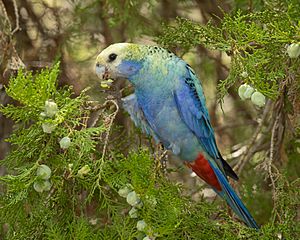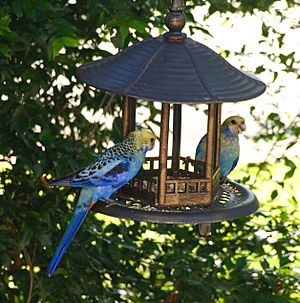Pale-headed rosella facts for kids
Quick facts for kids Pale-headed rosella |
|
|---|---|
 |
|
| Pale-headed rosella | |
| Conservation status | |
| Scientific classification | |
| Genus: |
Platycercus
|
| Species: |
adscitus
|
The pale-headed rosella (Platycercus adscitus) is a colorful parrot found in northeastern Australia. It's a medium-sized bird with a light yellow head, mostly white cheeks, and a back with black and gold patterns. Its belly is a pretty pale blue. There are two types of this rosella, but some scientists think they might be the same as the eastern rosella.
These parrots live in open woodlands and eat seeds and fruits. Like other rosellas, they build their nests in hollows of big trees. Sometimes, they even nest in tree hollows that are underground! People also keep them as pet birds.
Contents
About the Pale-headed Rosella's Family
Scientists like to group animals to understand them better. The pale-headed rosella was first described by an English bird expert named John Latham in 1790.
There are two main types, or subspecies, of the pale-headed rosella. One is called palliceps and lives in eastern Queensland. It's sometimes known as the blue-cheeked rosella. The other is adscitus, found in the Cape York Peninsula.
For a long time, scientists thought the pale-headed rosella's closest relative was the eastern rosella. These two birds sometimes even have babies together where their homes meet. However, a study in 2017 looked at their DNA. It found that the pale-headed rosella is actually more closely related to the northern rosella. The eastern rosella is a different branch of the family tree.
Other names for this bird include mealy rosella or Moreton Bay rosella. The northern type is often called the blue-cheeked rosella.
What Does the Pale-headed Rosella Look Like?

The pale-headed rosella is about 33 cm (13 in) long. This length includes its long tail, which is about 15 cm (6 in). Its belly is a light blue color. Its upper chest and head are a pale cream-yellow. The tail feathers are blue-black and green, and the area under its tail is bright red.
The feathers on its neck, shoulders, and back are black. Each black feather has a bright yellow edge, which makes the bird look like it has a cool scalloped pattern. In the northern type of rosella, this yellow color is even paler, with a hint of light blue.
The southern type has cheeks that are completely white. But the northern type has some blue mixed in with the white on its lower cheeks. The bird's beak is a pale blue-white, and its legs are dark grey. Its eyes are yellow-brown. Male and female rosellas look very similar. However, the female is usually a bit smaller and her colors are not quite as bright.
Where Do They Live? (Distribution and Habitat)
The main type of pale-headed rosella, adscitus, lives from the Cape York Peninsula down to Cardwell in central-northern Queensland. The southern type, palliceps, lives from Townsville south into northeastern New South Wales. You can find them near the Clarence River. These birds are quite common where they live.
They prefer to live in open forests. However, they have learned to live well in places where people have changed the land, like farms. They can even become a problem for fruit orchards and grain fields. Water troughs help these birds survive in the drier western parts of their home range.
What Do Pale-headed Rosellas Eat?
Pale-headed rosellas eat seeds from grasses and trees. They also enjoy fruits. Some of their favorite foods include seeds from the river red-gum (Eucalyptus camaldulensis), river she-oak (Casuarina cunninghamiana), and snow-in-summer (Melaleuca linariifolia). They also eat seeds from other melaleuca plants and rough cockleburr (Xanthium strumarium). These birds even like the Scotch thistle (Onopordum acanthium), which is a plant brought in from other places.
Reproduction and Life Cycle
The time when pale-headed rosellas have their babies changes depending on where they live. Birds in the southern areas nest from September to December. Birds in the northern areas nest later, from February to June. They usually have one group of babies each year.
Their nest is almost always in a hollow inside a tree trunk. This hollow is usually more than 1 m (3 ft) deep. The nest can be as high as 30 m (100 ft) above the ground. But sometimes, they even find a hollow in a tree trunk that is underground!
A female rosella usually lays five or six eggs, but sometimes up to nine. The eggs are round, white, and a little bit shiny. Each egg measures about 26 x 22 mm.
Keeping Pale-headed Rosellas as Pets (Aviculture)
The pale-headed rosella is a strong bird and is fairly easy to care for if kept as a pet. However, they can be a bit aggressive. Because of this, it's a good idea to keep them separate from other birds if you have them in an aviary.
See also
 In Spanish: Perico pálido para niños
In Spanish: Perico pálido para niños


